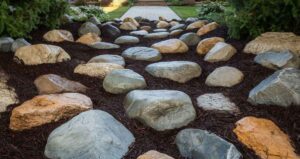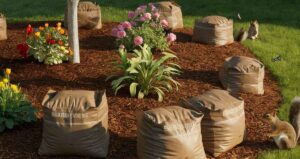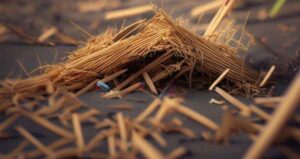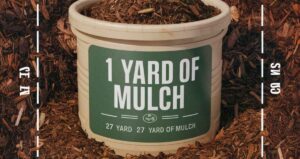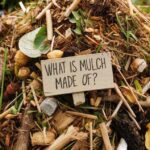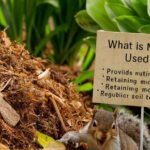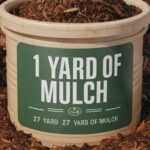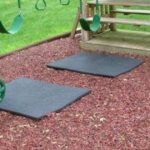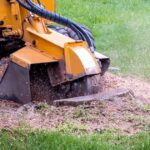Safeguard your mulch from termites by employing preventative measures such as using termite-resistant mulch, keeping it dry, and regularly inspecting for signs of termite activity.
Discover a foolproof method for eliminating termites in mulch effortlessly. Uncover strategic techniques to safeguard your garden and property from these destructive pests. Follow our expert advice to ensure a termite-free environment, allowing your plants to thrive without the threat of infestation. Terminate termites in mulch with confidence and ease.
Banish termites from your mulch with simple, effective strategies. Begin by removing infested mulch layers, and exposing termites to sunlight, their natural nemesis. Replace affected mulch with termite-resistant alternatives like cedar or cypress. Consider introducing nematodes, natural predators that feast on termites. Vigilance and swift action ensure a termite-free mulch bed.
How To Get Rid Of Termites In Mulch?
Mulch is a popular landscaping material known for its aesthetic appeal and ability to retain soil moisture. However, it can also become a breeding ground for termites, posing a threat to the structural integrity of your home.
Termites are notorious for causing extensive damage to wooden structures, and mulch provides them with a convenient source of food and shelter. In this guide, we’ll explore effective strategies on “How To Get Rid Of Termites In Mulch” to safeguard your property and keep these destructive pests at bay.
| Methods | Description |
| 1. Choose Termite-Resistant Mulch | Opt for mulch varieties that are less attractive to termites, such as rubber, gravel, or certain hardwoods. |
| 2. Maintain Proper Distance | Keep mulch at least 12 inches away from the foundation of your home to reduce the risk of termite infestation. |
| 3. Regular Inspection | Routinely inspect mulch for signs of termite activity, such as mud tubes or damaged wood, and take prompt action. |
| 4. Use Beneficial Nematodes | Introduce beneficial nematodes to the soil, as they are natural predators of termites and can help control their population. |
| 5. Apply Neem Oil | Neem oil has natural insect-repelling properties; apply it to the mulch to deter termites and protect your landscape. |
| 6. Sunlight Exposure | Allow sunlight to reach the soil beneath the mulch, as termites thrive in dark, moist environments. |
| 7. Remove Infested Mulch | If termites are already present, promptly remove and replace infested mulch to prevent further damage. |
Implementing these strategies will help you maintain a termite-free environment around your property and protect it from potential damage caused by these wood-destroying pests.
Fortifying Your Home Against Termites
In the battle against termites in mulch, a multi-faceted approach is the key to success. By combining preventive measures, natural remedies, and strategic chemical solutions, homeowners can create an environment that is unwelcoming to termites.
Regular inspections and professional assistance add an extra layer of protection, ensuring that your home and landscaping remain resilient against the silent threat of termite damage. Stay vigilant, implement these strategies, and enjoy a termite-free environment around your property.
Recognizing the Termite Challenge
Termites, often referred to as “silent destroyers,” are small, social insects that feed on cellulose-rich materials, including wood. Understanding their biology and behavior is crucial for developing effective strategies to combat their presence in mulch.
Termite Biology and Behavior
Termites operate in colonies with distinct castes, each serving specific roles. Workers gather food, soldiers defend the colony, and reproductives ensure the colony’s survival by producing new members.
Mulch as an Attractive Habitat
Mulch, designed to enrich soil and enhance landscaping, provides termites with an accessible source of food and a conducive environment for nesting. The cellulose content in wood-based mulch makes it particularly attractive to these pests.
But First, What Are Termites?
Before delving into strategies to eliminate termites in mulch, it’s essential to understand what termites are and why they pose a threat to your property. Termites are small, social insects belonging to the order Isoptera, known for their ability to feed on cellulose-rich materials like wood. Often referred to as “silent destroyers,” termites can cause extensive damage to homes and structures by consuming wooden elements, such as beams, frames, and furniture.
These pests operate in colonies, with different castes serving specific roles. The worker termites are responsible for gathering food, which includes wood and other plant materials. Soldiers defend the colony against threats, while reproductive termites ensure the colony’s survival by producing new members.
Termites play a vital ecological role by breaking down dead and decaying wood in forests, contributing to nutrient cycling. However, when they infiltrate residential areas, their feeding habits can lead to severe structural damage.
Understanding the biology and behavior of termites is crucial in developing effective strategies to prevent and eliminate their presence in places like mulch beds. Now, let’s explore how to safeguard your property from these destructive insects when they take refuge in mulch.
Why Do I Have Termites In Mulch?
Termites in mulch can be a cause for concern, and several factors contribute to their presence in these landscaping materials. Understanding these reasons can help you take proactive steps to mitigate the risk of termite infestation in your mulch beds:
Cellulose Attraction
Termites feed on cellulose, a compound found in plant materials, including wood and mulch. Mulch provides a readily available food source, making it an attractive environment for termites to thrive.
Moisture Retention
Termites are drawn to damp and moist environments. Mulch, which is designed to retain moisture and regulate soil temperature, creates an ideal habitat for termites, especially if it remain consistently wet.
Proximity to Structures
Mulch beds placed too close to the foundation of your home create a bridge for termites to access wooden structures. Termites can easily transition from mulch to the wooden components of your house, posing a risk of structural damage.
Lack of Sunlight Exposure
Termites prefer dark and concealed spaces. Mulch that is thick and not exposed to sunlight provides a suitable hiding place for these pests. Sunlight helps keep the soil beneath the mulch dry, making it less favorable for termite activity.
Wood Type Used in Mulch
Some mulch materials are more attractive to termites than others. Mulches made from softwoods or certain hardwoods may be more prone to termite infestation. Choosing termite-resistant mulch varieties can be a preventive measure.
Neglected Maintenance
Mulch that is not regularly inspected or maintained may become a breeding ground for termites. Lack of attention to mulch beds allows termite populations to grow unchecked.
Understanding these factors can guide you in taking proactive measures to prevent and address termite issues in your mulch. By choosing termite-resistant mulch, maintaining proper distances from structures, ensuring good sunlight exposure, and practicing regular inspections, you can reduce the risk of termite infestations in your landscaping.
Best Products For How To Get Rid Of Termites In Mulch
When dealing with termites in mulch, it’s essential to choose effective products that target these pests while considering the safety of your plants and the environment. Here are some recommended products for getting rid of termites in mulch:
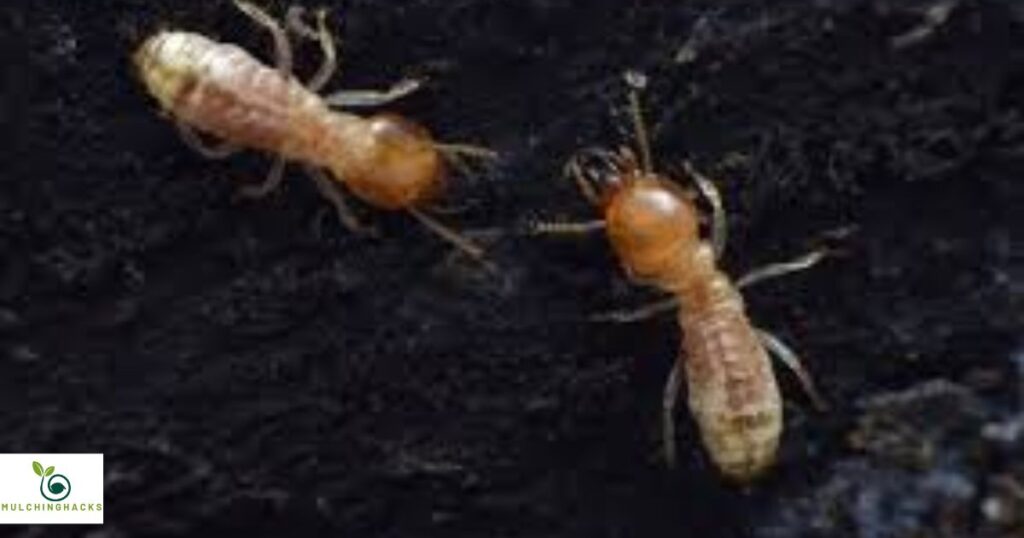
Termite-Resistant Mulch
Choose mulch varieties that termites find less attractive. Options like rubber, gravel, or hardwoods with natural termite resistance can help create a less hospitable environment for termites
Beneficial Nematodes
Beneficial nematodes are microscopic organisms that prey on termites and other soil-dwelling pests. They are a natural and environmentally friendly solution to control termite populations in mulch.
Neem Oil
Neem oil has insect-repelling properties and can be applied to mulch as a deterrent for termites. It is a natural and non-toxic solution that won’t harm plants but can effectively discourage termite activity.
Termite Bait Systems
Termite bait systems, such as those containing cellulose or other attractive substances, can be strategically placed in mulch beds. Termites feed on the bait and carry it back to the colony, effectively reducing termite populations.
Liquid Termite Insecticides
Liquid termiticides, when applied to the soil around mulch beds, create a protective barrier against termites. These insecticides are often long-lasting and can help prevent termite infestations.
Diatomaceous Earth
Diatomaceous earth is a natural insecticide that is safe for plants but harmful to termites. When sprinkled on mulch, it can help control termite populations by dehydrating and damaging their exoskeletons.
Boric Acid
Boric acid is another effective termite treatment. It can be applied to mulch as a powder or solution, acting as a slow-acting poison that termites carry back to the colony, eventually leading to their elimination.
Soil Solarization
Solarizing the soil beneath the mulch by exposing it to sunlight can help reduce termite activity. This method involves covering the mulch with a clear plastic sheet, trapping heat, and effectively eliminating termites in the topsoil.
Before using any products, it’s crucial to read and follow the instructions carefully. Additionally, consider consulting with a pest control professional to determine the most suitable approach for your specific situation. Integrated pest management, combining multiple strategies, is often the most effective way to address termite issues in mulch beds.
Spectracide Terminate Termite Killing Stakes
As of my last knowledge update in January 2022, Spectracide Terminate Termite Killing Stakes is a termite control product designed for homeowners to use around their property. Keep in mind that product formulations and availability may change, so it’s a good idea to check the latest product information and follow the instructions provided on the product packaging.
Here are some general points about Spectracide Terminate Termite Killing Stakes:
Bait System
Spectracide Terminate Termite Killing Stakes operate as a bait system. The stakes are placed in the ground around the perimeter of a structure, and termites are attracted to the bait inside the stakes.
Active Ingredient
The active ingredient in these stakes is typically hexaflumuron, a slow-acting insect growth regulator that disrupts the termites’ ability to molt, ultimately leading to colony elimination.
Installation
Users typically install the stakes by inserting them into the ground at specified intervals around the home. The stakes contain a monitoring base and a termite bait cartridge.
Monitoring and Baiting
Initially, the stakes serve as monitoring devices, allowing you to check for termite activity. If termites are found, the monitoring base can be replaced with a baited cartridge. Termites feed on the bait and then carry it back to the colony, disrupting the termite life cycle.
Regular Inspection
Regular inspection of the stakes is recommended to monitor termite activity. If termites are present, the bait can be replaced to continue the control process.
Caution and Guidelines
As with any pesticide, it’s crucial to follow the product’s instructions and safety guidelines. If you have concerns or questions about the use of the product, consulting with a pest control professional is advisable.
Always check for the most up-to-date information on the product label or the manufacturer’s website. Additionally, local regulations and product availability may vary, so be sure to comply with any relevant guidelines in your area.
Building a Termite-Resistant Environment
Building a termite-resistant environment is a proactive and crucial step in protecting your property from the destructive impact of termites. Termites, often referred to as “silent destroyers,” can cause extensive damage to wooden structures, compromising the integrity of homes and buildings. By implementing strategies to deter termites and creating an environment less conducive to their activity, homeowners can significantly reduce the risk of infestation. Let’s explore key measures for building a termite-resistant environment:
Termite-Resistant Mulch Varieties
Choosing the right mulch is a foundational step in building a termite-resistant environment. Opt for mulch varieties that termites find less appealing. Rubber, gravel, or certain hardwoods are excellent choices that can help create an environment that is less attractive to termites.
Proper Mulch Placement
Maintaining a suitable distance between mulch beds and the foundation of your home is essential. Keep mulch at least 12 inches away from the structure to prevent termites from easily accessing wooden components. This physical barrier helps minimize the risk of termites bridging from the mulch to your home.
Termite-Resistant Wood Treatments
If using wood-based mulch, consider treating it with termite-resistant products. These treatments create a protective barrier on the mulch, making it less susceptible to termite infestation. Applying termite-resistant treatments can significantly enhance the durability of the mulch in deterring termite activity.
Proper Drainage and Moisture Control
Termites thrive in moist environments. Implementing proper drainage and moisture control measures around your property is crucial. Ensure that water drains away from the foundation, and address any leaks or water accumulation promptly. By keeping the soil dry, you make the environment less hospitable for termites.
Regular Inspection Schedule
Regular inspections are a cornerstone of termite prevention. Establish a routine inspection schedule for both your home’s foundation and mulch beds. Look for signs of termite activity, such as mud tubes, damaged wood, or swarming termites. Early detection allows for prompt intervention and minimizes potential damage.
Beneficial Nematodes
Introducing beneficial nematodes to the soil around mulch beds is a natural and effective way to control termite populations. These microscopic organisms act as natural predators, feeding on termites and disrupting their colonies. Beneficial nematodes contribute to creating a balanced and termite-resistant ecosystem.
Harris Termite Powder
In the quest for effective termite control, Harris Termite Powder emerges as a versatile solution, showcasing the brand’s commitment to providing homeowners with reliable pest management options.
Tailored to address termite infestations, this powder is designed with a potent blend of active ingredients, promising a strategic approach to eliminating these wood-devouring pests.
Harris, a trusted name in the pest control industry, has formulated a product that aims to strike a balance between efficacy and ease of use, empowering users to take proactive measures against termites with confidence.
Let’s delve into the features, application methods, and considerations that make Harris Termite Powder a valuable tool in the ongoing battle against termite invasions.
Advance Termite Bait Stations
In the relentless battle against termite invasions, Advance Termite Bait Stations stand as innovative defenders of homes, offering a strategic and proactive approach to termite control.
Crafted with precision and backed by cutting-edge technology, these bait stations represent a sentinel solution designed to detect, monitor, and eliminate termite colonies with unparalleled efficiency.
Developed for ease of use by homeowners, Advance Termite Bait Stations blend simplicity with sophistication, empowering individuals to safeguard their properties from the silent threat of termite damage. Stations are a reliable ally in the ongoing quest to protect homes from the destructive forces of termites.
Trelona Compressed Termite Bait Box
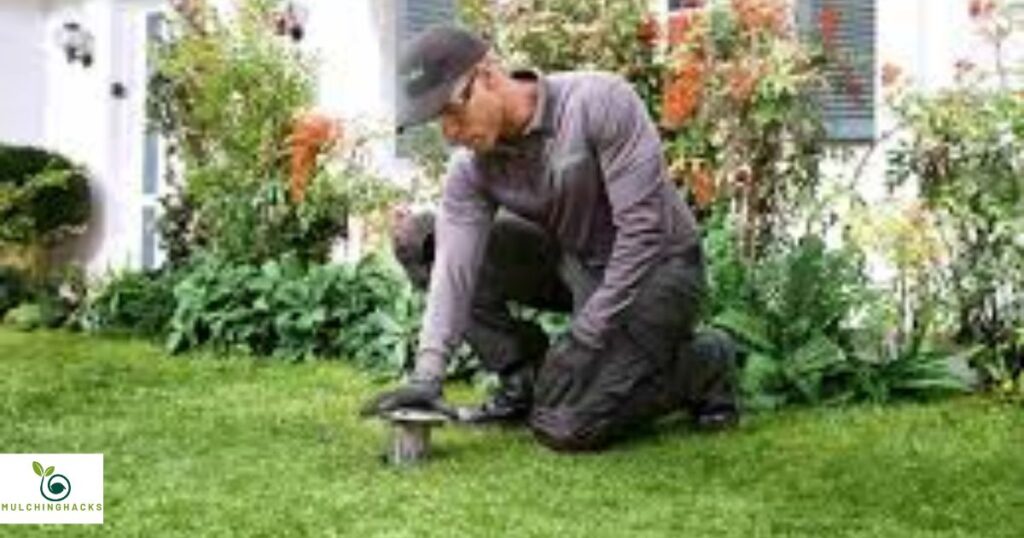
Enter the realm of termite defense with the Trelona Compressed Termite Bait Box, a beacon of cutting-edge technology in the fight against these relentless invaders. Merging simplicity with efficacy, Trelona’s innovative bait box is designed to provide homeowners with a powerful tool for termite detection and eradication.
Its compact yet potent design conceals a formidable punch, offering a discreet and efficient solution to monitor and control termite colonies. Tailored for easy implementation, the Trelona Compressed Termite Bait Box redefines convenience in termite management, promising a proactive shield against the unseen threat beneath the soil.
As we explore the features and workings of this advanced termite defense system, it becomes clear that Trelona has not only raised the bar but has set a new standard in the ongoing quest to fortify homes against the silent architects of structural damage.
Diatomaceous Earth Crawling Insect Killer
Diatomaceous Earth Crawling Insect Killer represents a natural and versatile solution in the realm of pest control. Harnessing the power of diatoms, fossilized algae with microscopic razor-sharp edges, this insect killer provides an eco-friendly and effective method to combat crawling pests.
Its unique mode of action involves piercing the exoskeleton of insects, leading to dehydration and eventual demise. Easy to use and safe for both humans and pets, diatomaceous earth serves as a formidable barrier against a variety of crawling pests, including ants, cockroaches, and bedbugs.
As we delve into the features and applications of this natural insect killer, it becomes evident that it is not only a reliable guardian for homes and gardens but also an environmentally conscious choice for those seeking a pesticide-free approach to pest management.
Best Products For How To Protect Your Home From Termites In Mulch
Protecting your home from termites in mulch requires a combination of preventive measures and effective products. Here are some recommended products and strategies to safeguard your home:
Termite-Resistant Mulch
Choose mulch varieties that are naturally resistant to termites. Rubber, gravel, or certain hardwoods are less attractive to termites and can help create a less hospitable environment.
Beneficial Nematodes
Introduce beneficial nematodes to the soil. These microscopic organisms are natural predators of termites and can help control termite populations in mulch beds.
Termite Barrier Treatments
Apply liquid termite barrier treatments around the foundation of your home. These treatments create a protective barrier that deters termites from approaching your house.
Termite Bait Systems
Install termite bait systems around the perimeter of your property. These systems use bait stations to attract termites, disrupting their colonies and preventing them from reaching your home.
Termite-Resistant Wood Treatments
If using wood-based mulch, consider treating it with termite-resistant products. These treatments create a barrier that makes the mulch less appealing to termites.
Neem Oil
Neem oil has natural insect-repelling properties. Applying neem oil to the mulch can act as a deterrent, discouraging termites from infesting the area.
Regular Inspection
Conduct routine inspections of your mulch beds for signs of termite activity. Early detection allows for prompt action to prevent infestations from spreading.
Sunlight Exposure
Ensure that the mulch is not too thick and allows sunlight to reach the soil. Termites thrive in dark, moist environments, so proper exposure to sunlight can discourage their activity.
Professional Pest Control Services
Consider hiring professional pest control services for regular inspections and preventive treatments. Professionals can provide tailored solutions based on the specific needs of your property.
Remember to follow product instructions carefully and, when in doubt, consult with a pest control professional for guidance. Combining these products and strategies will create a comprehensive defense against termites in mulch, helping to protect your home from potential damage.
Home Remedies For How To Get Rid Of Termites In Mulch
In the intricate tapestry of landscaping, mulch not only enhances the aesthetic appeal but can inadvertently become a haven for termites, posing a threat to the very structures it surrounds.
While professional pest control is the gold standard, exploring home remedies offers an initial line of defense against these wood-devouring pests. Delving into the realm of DIY termite control, one can employ a variety of natural substances and concoctions to discourage termite activity in mulch.
From the microscopic warriors, and beneficial nematodes, to the desiccating prowess of diatomaceous earth, each remedy aims to disrupt termite colonies and protect your outdoor spaces.
Neem oil and orange oil, derived from nature’s arsenal, emerge as potential deterrents, while household staples like salt and vinegar contribute to a multifaceted approach. With these home remedies, one can weave an eco-friendly shield around their mulch beds, fostering a resilient defense against the silent threat of termite damage.
How To Manage And Prevent Termites In Mulch
Effectively managing and preventing termites in mulch requires a comprehensive approach that combines regular inspections, proper landscaping practices, and, if necessary, the use of termite-resistant materials. Here’s a guide on how to manage and prevent termites in mulch:
Choose Termite-Resistant Mulch
Opt for mulch varieties that termites find less attractive. Rubber, gravel, or certain hardwoods are examples of materials less prone to termite infestation.
Maintain Distance from Structures
Keep mulch beds at least 12 inches away from the foundation of your home. This reduces the risk of termites bridging from the mulch to the wooden components of your house.
Regular Inspection
Routinely inspect mulch beds for signs of termite activity. Look for mud tubes, damaged wood, or any indications of termite presence. Early detection is crucial for effective management.
Termite-Resistant Wood Treatments
If using wood-based mulch, consider treating it with termite-resistant products. These treatments create a protective barrier, making the mulch less appealing to termites.
Beneficial Nematodes
Introduce beneficial nematodes to the soil in and around mulch beds. These microscopic organisms are natural predators of termites and can help control their population.
Diatomaceous Earth
Apply food-grade diatomaceous earth to the mulch. This natural substance has microscopic sharp edges that can dehydrate and kill termites upon contact.
Neem Oil Application
Use neem oil as a natural termite deterrent. Mix neem oil with water and apply it to the mulch, creating an environment that termites find inhospitable.
Solarization
Allow sunlight to reach the soil beneath the mulch. Termites thrive in dark, moist environments, so exposing the area to sunlight can help reduce termite activity.
Regular Mulch Replacement
Consider replacing mulch regularly. This disrupts termite habitats and prevents the accumulation of moist conditions that attract termites.
Professional Inspection
Periodically seek professional pest control services for a thorough termite inspection. Professionals can identify potential risks and provide tailored recommendations for your specific situation.
By combining these practices, you can create an environment that is less conducive to termite activity and minimize the risk of infestation in your mulch beds. Regular vigilance and a proactive approach are key elements in effective termite management and prevention.
FAQ,s
What attracts termites to mulch?
Termites are drawn to mulch because it provides them with a food source. Mulch, especially wood-based varieties, contains cellulose that termites feed on.
Can I use any mulch to avoid termites?
Choosing termite-resistant mulch, such as rubber, gravel, or certain hardwoods, can make your mulch less attractive to termites and help prevent infestations.
How do I know if termites are in my mulch?
Watch for signs like mud tubes, damaged wood, or the presence of termites. Regular inspections can help detect termite activity early.
Are there natural ways to get rid of termites in mulch?
Yes, natural solutions like beneficial nematodes, diatomaceous earth, and neem oil can help control termites in mulch without using harsh chemicals.
Conclusion
Safeguarding your mulch against termites involves a multi-pronged approach. Opt for termite-resistant mulch varieties, maintain proper distances from structures, and employ natural remedies like beneficial nematodes or neem oil. Regular inspections, early detection, and professional assistance further fortify your defense.
By creating an environment that is less conducive to termite activity and implementing preventive measures, you not only protect your landscape but also ensure the longevity of your property. Remember, the key lies in proactive strategies and a vigilant eye, allowing you to enjoy your outdoor spaces without the silent threat of termite damage in your mulch beds.



